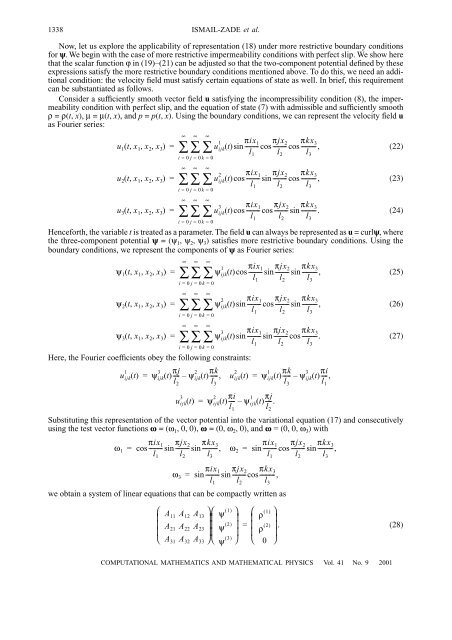Numerical Simulation of Three-Dimensional Viscous Flows with ...
Numerical Simulation of Three-Dimensional Viscous Flows with ...
Numerical Simulation of Three-Dimensional Viscous Flows with ...
Create successful ePaper yourself
Turn your PDF publications into a flip-book with our unique Google optimized e-Paper software.
1338<br />
ISMAIL-ZADE et al.<br />
Now, let us explore the applicability <strong>of</strong> representation (18) under more restrictive boundary conditions<br />
for y. We begin <strong>with</strong> the case <strong>of</strong> more restrictive impermeability conditions <strong>with</strong> perfect slip. We show here<br />
that the scalar function ϕ in (19)–(21) can be adjusted so that the two-component potential defined by these<br />
expressions satisfy the more restrictive boundary conditions mentioned above. To do this, we need an additional<br />
condition: the velocity field must satisfy certain equations <strong>of</strong> state as well. In brief, this requirement<br />
can be substantiated as follows.<br />
Consider a sufficiently smooth vector field u satisfying the incompressibility condition (8), the impermeability<br />
condition <strong>with</strong> perfect slip, and the equation <strong>of</strong> state (7) <strong>with</strong> admissible and sufficiently smooth<br />
ρ = ρ(t, x), µ = µ(t, x), and p = p(t, x). Using the boundary conditions, we can represent the velocity field u<br />
as Fourier series:<br />
∞<br />
∞<br />
∞<br />
1 πix<br />
u 1 ( t, x 1 , x 2 , x 3 ) u ijk () t<br />
1 πjx<br />
--------- 2 πkx<br />
= ∑ ∑ ∑ sin cos---------<br />
cos---------- 3<br />
,<br />
l 1 l 2 l 3<br />
i = 0 j = 0 k = 0<br />
∞<br />
∞<br />
∞<br />
2 πix<br />
u 2 ( t, x 1 , x 2 , x 3 ) u ijk () t<br />
1 πjx<br />
--------- 2 πkx<br />
= ∑ ∑ ∑ cos sin---------<br />
cos---------- 3<br />
,<br />
l 1 l 2 l 3<br />
i = 0 j = 0 k = 0<br />
∞<br />
∞<br />
∞<br />
3 πix<br />
u 3 ( t, x 1 , x 2 , x 3 ) u ijk () t<br />
1 πjx<br />
--------- 2 πkx<br />
= ∑ ∑ ∑ cos cos---------<br />
sin---------- 3<br />
.<br />
(24)<br />
l 1 l 2 l 3<br />
i = 0 j = 0 k = 0<br />
Henceforth, the variable t is treated as a parameter. The field u can always be represented as u = curly, where<br />
the three-component potential y = (ψ 1 , ψ 2 , ψ 3 ) satisfies more restrictive boundary conditions. Using the<br />
boundary conditions, we represent the components <strong>of</strong> y as Fourier series:<br />
∞<br />
∞<br />
∞<br />
1 πix<br />
ψ 1 ( t, x 1 , x 2 , x 3 ) ψ ijk () t<br />
1 πjx<br />
--------- 2 πkx<br />
= ∑ ∑ ∑ cos sin---------<br />
sin---------- 3<br />
,<br />
l 1 l 2 l 3<br />
i = 0 j = 0 k = 0<br />
∞<br />
∞<br />
∞<br />
2 πix<br />
ψ 2 ( t, x 1 , x 2 , x 3 ) ψ ijk () t<br />
1 πjx<br />
--------- 2 πkx<br />
= ∑ ∑ ∑ sin cos---------<br />
sin---------- 3<br />
,<br />
l 1 l 2 l 3<br />
i = 0 j = 0 k = 0<br />
∞<br />
3 πix<br />
ψ 3 ( t, x 1 , x 2 , x 3 ) ψ ijk () t<br />
1 πjx<br />
--------- 2 πkx<br />
= ∑ ∑ ∑ sin sin---------<br />
cos---------- 3<br />
.<br />
l 1 l 2 l 3<br />
i = 0 j = 0 k = 0<br />
Here, the Fourier coefficients obey the following constraints:<br />
1<br />
u ijk<br />
∞<br />
∞<br />
3<br />
() t ψ ijk () t ---- πj 2<br />
ψ ijk () t -----, πk 2<br />
1<br />
– u ijk () t ψ ijk () t ----- πk 3<br />
= = – ψ ijk () t ----,<br />
πi<br />
l 2<br />
3<br />
u ijk<br />
l 3<br />
2<br />
() t ψ ijk () t ---- πi 1<br />
= – ψ ijk () t ----.<br />
πj<br />
Substituting this representation <strong>of</strong> the vector potential into the variational equation (17) and consecutively<br />
using the test vector functions w = (ω 1 , 0, 0), w = (0, ω 2 , 0), and w = (0, 0, ω 3 ) <strong>with</strong><br />
l 1<br />
l 2<br />
l 3<br />
l 1<br />
(22)<br />
(23)<br />
(25)<br />
(26)<br />
(27)<br />
πix<br />
ω 1 πjx<br />
1 --------- --------- 2 πkx<br />
= cos sin sin---------- 3<br />
, ω 2 =<br />
l 1<br />
l 2<br />
l 3<br />
πix 1 πjx<br />
--------- 2 πkx<br />
sin cos---------<br />
sin---------- 3<br />
,<br />
l 1 l 2 l 3<br />
πix<br />
ω 1 πjx<br />
3 --------- --------- 2<br />
cos πkx 3<br />
= sin sin ---------- ,<br />
l 1 l 2 l 3<br />
we obtain a system <strong>of</strong> linear equations that can be compactly written as<br />
⎛ A 11 A 12 A ⎞⎛<br />
13 ψ ( 1)<br />
⎞<br />
⎜<br />
⎟⎜<br />
⎟<br />
⎜ A 21 A 22 A 23<br />
⎟⎜<br />
ψ ( 2)<br />
⎟<br />
⎜<br />
⎟⎜<br />
⎟<br />
⎝ A 31 A 32 A 33 ⎠⎝<br />
⎠<br />
ψ ( 3)<br />
⎛<br />
⎜<br />
= ⎜<br />
⎜<br />
⎝<br />
ρ ( 1)<br />
ρ ( 2)<br />
0<br />
⎞<br />
⎟<br />
⎟.<br />
⎟<br />
⎠<br />
(28)<br />
COMPUTATIONAL MATHEMATICS AND MATHEMATICAL PHYSICS Vol. 41 No. 9 2001



